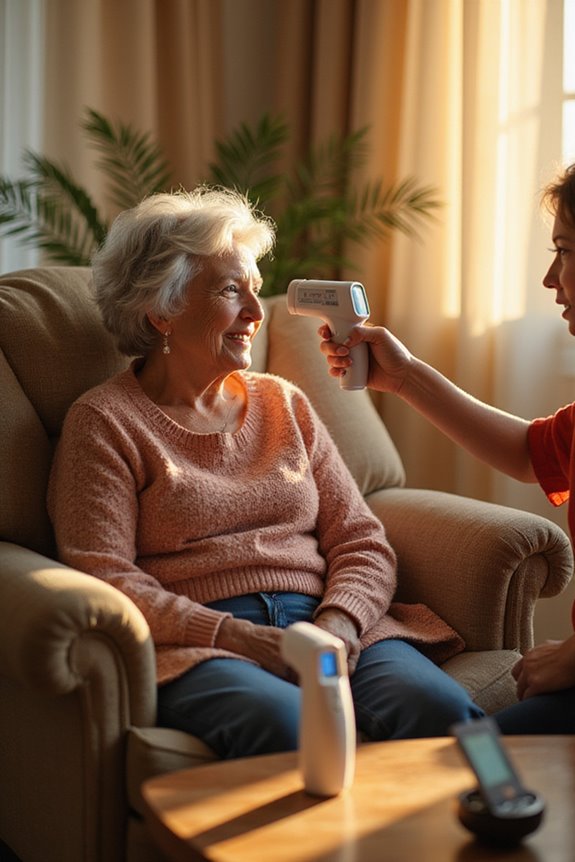Digital thermometers provide accurate internal temperature readings, typically within 10 to 30 seconds, requiring direct contact. Infrared thermometers, on the other hand, deliver instant readings in less than a second without contact. They are often used for surface temperatures and are essential in healthcare and food safety due to their hygiene benefits. Cost varies considerably, with infrared models ranging from $13 to over $500. Further insights on these devices and their applications follow.
Key Takeaways
- Infrared thermometers provide instantaneous readings and are non-contact, while digital thermometers take longer and require direct contact for accurate measurements.
- Accuracy varies: infrared thermometers may register lower temperatures compared to rectal measurements, while tympanic thermometers are sensitive to fever detection.
- Infrared models are ideal for surface temperature checks in food safety and equipment maintenance, enhancing versatility in various applications.
- Digital thermometers are generally more affordable, with basic models under $50, compared to infrared thermometers ranging from $13 to over $500.
- Non-contact infrared thermometers reduce the risk of infection and ensure hygiene, making them suitable for public and healthcare settings.
Accuracy and Measurement Differences
Accuracy in temperature measurement is critical in both clinical and home settings. The choice of thermometer can greatly influence results due to accuracy variability.
- Infrared Thermometers: These devices often exhibit bias, providing lower readings than contact thermometers. Environmental factors, such as ambient temperature and distance, can further impact their accuracy. Additionally, the adjustable emissivity settings of infrared thermometers can enhance measurement precision across different materials.
- Digital Thermometers: Typically, these offer consistent readings comparable to mercury thermometers. However, measurement techniques, including the anatomical site, lead to variances. Rectal measurements yield the most accurate baseline, while axillary and forehead readings are often lower.
- Comparative Sensitivity: Tympanic and temporal artery thermometers showcase higher sensitivity for detecting fever, although they may still differ from core body temperature. Therefore, understanding these differences is essential for informed decision-making.
Speed and Convenience
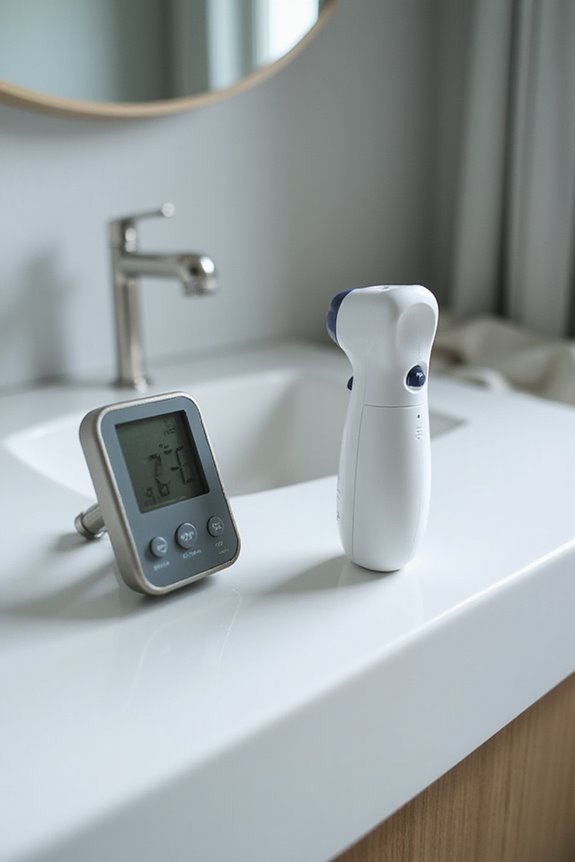
When considering thermometers, speed and convenience often emerge as critical factors influencing their selection, particularly in settings that demand rapid assessments. Infrared thermometers deliver instantaneous readings, typically within less than a second, greatly enhancing reading speed compared to digital thermometers, which require 10 to 30 seconds for stabilization.
Key aspects include:
- User Experience: Infrared models require minimal contact, simplifying usage and expediting the process.
- Portability: Their lightweight, cordless design enhances convenience, allowing for easy deployment in various environments.
- Versatility: Infrared thermometers can measure temperature from a distance and on multiple surfaces, adding to their functionality.
These features support efficient workflows, reduce patient discomfort, and enable rapid screenings in high-traffic areas, making infrared thermometers a preferred choice for many users.
Hygiene and Safety
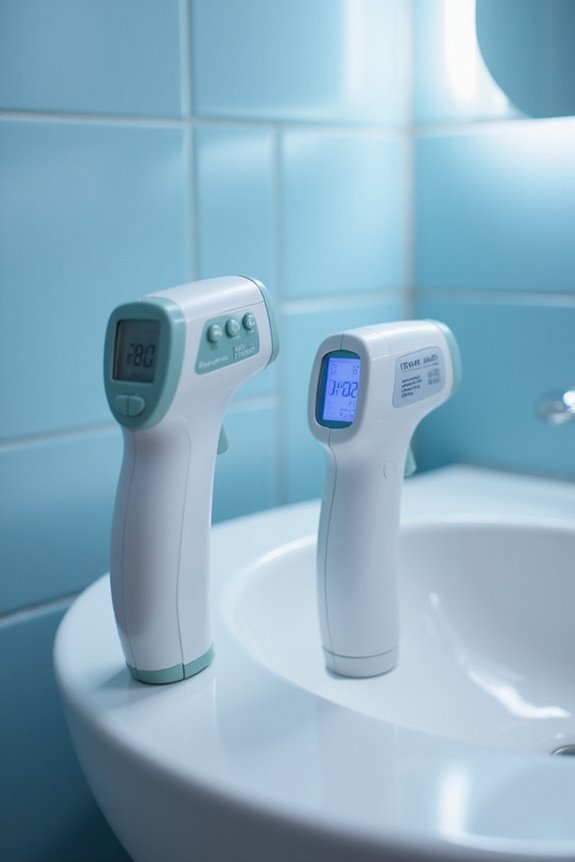
Hygiene and safety are paramount concerns in the selection of thermometers, especially in healthcare and public settings. Infrared thermometers meet higher hygiene standards due to their non-contact operation, greatly reducing the risk of cross-contamination.
Key points include:
- Non-Contact Advantage: Minimizes infection spread, essential in patient care.
- Mercury-Free: Eliminates health hazards associated with traditional thermometers.
- Antimicrobial Features: Some models incorporate materials that enhance hygiene.
- Ease of Cleaning: Digital thermometers, especially non-contact types, require less maintenance, ensuring a sterile environment.
Versatility and Application Scope
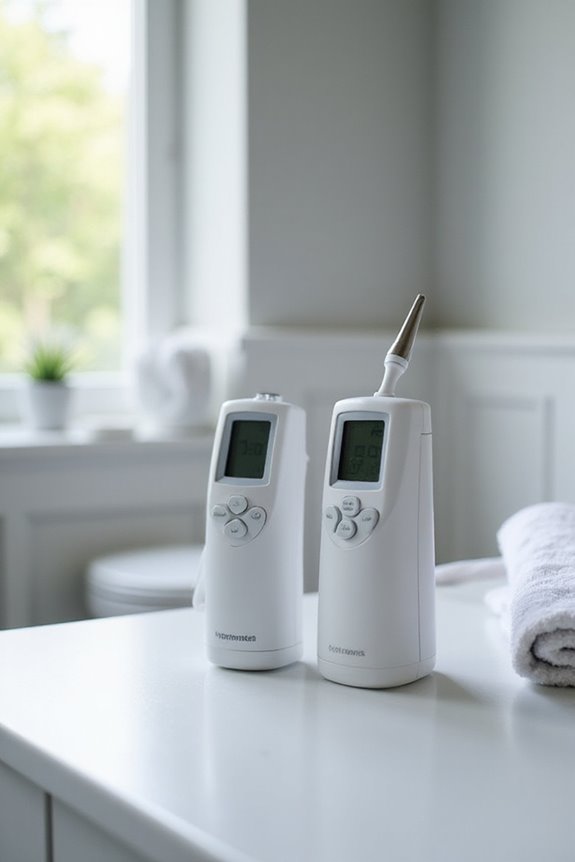
Versatility in thermometer technology allows for a wide range of applications across various industries, enhancing operational efficiency and safety.
Industrial Applications
- Infrared thermometers are ideal for monitoring surface temperatures of equipment like boilers and electrical panels without direct contact.
- They facilitate preventive maintenance, detecting faults early and minimizing downtime.
- Digital thermometers, while accurate for internal measurements, are less suited for industrial use due to their need for direct contact.
Food Safety
- Digital thermometers guarantee compliance with food safety standards by measuring internal temperatures, essential for preventing bacterial growth.
- Infrared thermometers provide rapid surface temperature checks, complementing digital devices for thorough monitoring in kitchens.
- Both technologies play significant roles in maintaining food safety across culinary environments, especially when considering temperature range to ensure accurate readings.
Cost and Power Requirements
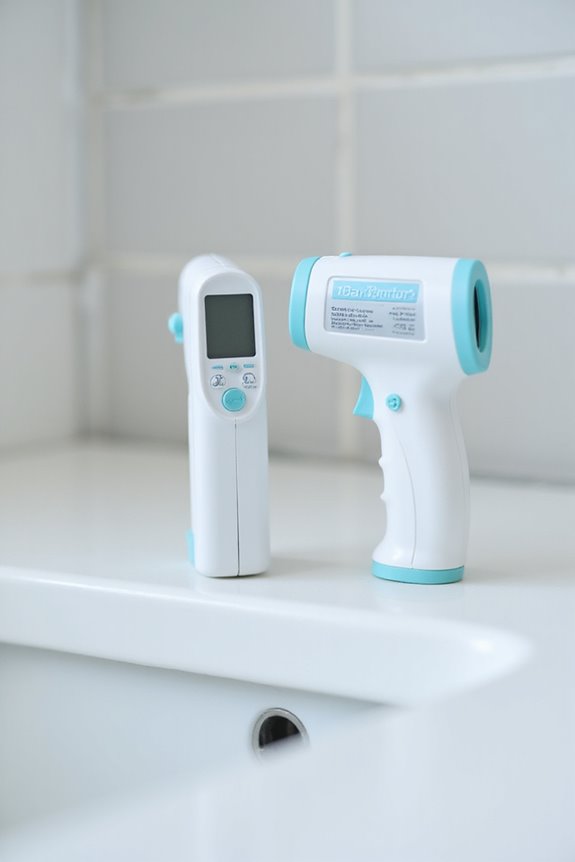
Cost and power requirements are crucial factors influencing the selection of thermometers, particularly in industrial and food safety applications.
Cost Analysis
- Infrared thermometers range from $13 to over $500, depending on features like data logging and adjustable emissivity.
- Digital thermometers often cost less, with many basic models priced under $50, but advanced features can increase costs.
- The overall investment varies considerably based on intended use and accuracy needs.
Battery Efficiency
- Infrared thermometers typically utilize AAA or AA batteries, featuring low power consumption and auto-shutoff for battery efficiency.
- Digital models often use button cell or AAA batteries, with some designed for plug-in use.
- Consideration of battery life and replacement costs is essential in the thorough cost analysis of both thermometer types.
Frequently Asked Questions
How Do I Properly Clean Digital and Infrared Thermometers?
Properly cleaning thermometers is essential for accurate readings. Effective cleaning methods include gentle wiping, disinfecting, and thorough drying. Regular thermometer maintenance guarantees longevity, fostering a sense of trust and community in health management practices.
Can I Use an Infrared Thermometer for Cooking?
Using an infrared thermometer for cooking can effectively monitor cooking temperatures, enhancing food safety. It provides quick surface temperature checks, although it cannot measure internal temperatures, making it a valuable tool for various kitchen tasks.
Are There Specific Brands Recommended for Accuracy?
Despite concerns over varying accuracy, several brands are recommended for precision. Notable options include Vicks, Braun, and Exergen, each demonstrating strong accuracy comparisons, fostering confidence for users seeking reliable temperature measurement solutions.
How Long Do Batteries Typically Last in These Thermometers?
Battery longevity varies considerably among thermometers, typically lasting from 20 to 500 hours. Users should consider how temperature accuracy impacts their choice, as efficient devices often maximize battery performance through features like auto shut-off.
What Is the Lifespan of Digital and Infrared Thermometers?
The lifespan comparison reveals that both thermometer types generally last between three to five years. Their durability depends on proper care and maintenance, ensuring reliable performance and consistent results for users in various environments.

